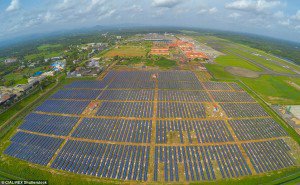in Kerala, India, is the first ever airport to be completely powered by solar.
There are many success stories when it comes to solar- people going off grid thanks to their rooftop solar power, giant companies funding and co-financing big solar arrays to account for their energy consumption. However, nothing is quite as big is the one I am going to tell you about here.
One of the largest international airports in India, Cochin airport, has just announced that they no longer pay electricity bills. Thanks to the massive solar array on the rooftops of the terminals, and around the airport, the establishment is now meeting all its energy needs on its own- no grid power needed.
The story goes about three years back, when the management team decided on mounting solar panels on the roof of the airport’s arrivals terminal building. The project was very successful and continued expanding. The airport hired Bosh, the famous German engineering company, to complete the plans. The result: $9.5 million, 12 MW solar plant, which contains 46,000 panels, covering 45 acres of otherwise unused land near the airport’s cargo section.
This solar array has been in operation since August, 2015. Since then, the Cochin airport‘s solar plant has been generating between 48,000 and 50,000 kilowatts of power per day, which easily covers the needs of the airport, and even a bit extra. All excess energy is sent to the power grid. With this, the airport becomes officially the world’s first airport fully powered by solar.
According to Jose Thomas, the general manager of Cochin airport, the investment will return in less than six years. Thomas proudly states that by using their home-made solar power, the airport will save 300,000 metric tons of carbon dioxide emissions, which would otherwise have been released from coal power plants in the next 25 years.
Of course the plans do not end here. The array is set to expand further along the irrigation canal near the airport, as well as across the new car park and more of the unused land nearby. The energy that this extension will generate will be used to power the brand new international airport terminal, which is soon to be added to the airport.
And if this was not enough, the airport managers are also looking into organic farming. The idea is to utilize all the water used to clean the solar panels and water crops grown on the same land where the array is located.























